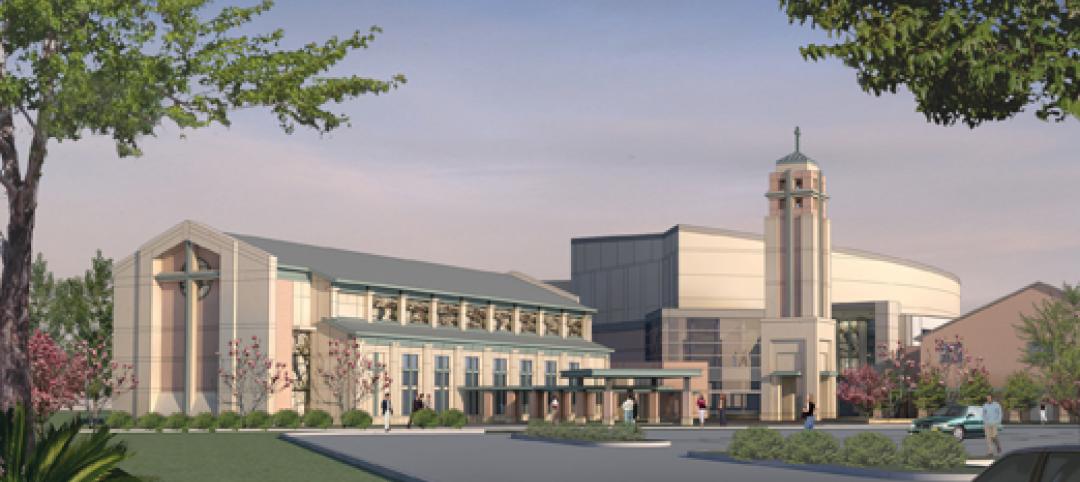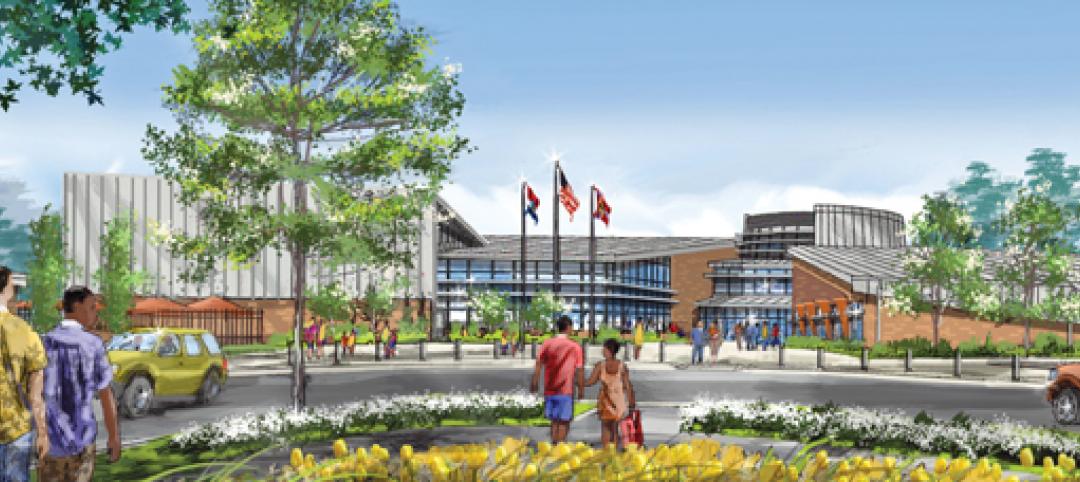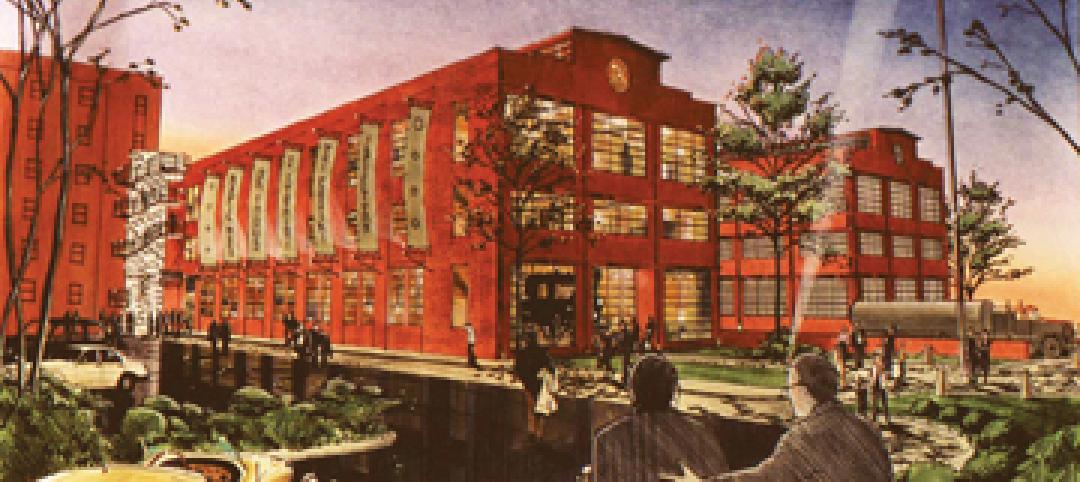 |
| EMPAC is built into a hillside overlooking the Hudson Valley on the RPI campus. Grimshaw’s design was chosen partially because of how it took advantage of the site. |
Rensselaer Polytechnic Institute, the nation's oldest technology university, has long prided itself on its state-of-the-art design and engineering curriculum. Several years ago, to call attention to its equally estimable media and performing arts programs, RPI commissioned British architect Sir Nicholas Grimshaw to design the Curtis R. Priem Experimental Media and Performing Arts Center (EMPAC).
As we recently noted (see “BIM + IPD: 3 Success Stories,” April;), Grimshaw's clever and dramatic “ship-in-a-bottle” structure has become the centerpiece of the Troy, N.Y. campus.
In judging the EMPAC project for the 2009 Building Team Awards, the judges were impressed with the way in which the Building Team addressed the site, a steep hillside overlooking the Hudson Valley. “One of the things that led to our decision to select Grimshaw was that they captured early on how to best take advantage of the site,” said Claude Rounds, the university's VP of administration. “They not only gave an architectural concept of how the structure would fit, but how it would actually complement and enhance the site.” From the early days of the project, RPI wanted a Building Team that would make the most effective use of the difficult site conditions.
 |
| The walls of EMPAC’s two studios are composed of adjustable acoustic diffusion panels painted matte black to allow an acoustic con• guration for any performance. Studio 1 (above) is capable of audio presentation but is optimized for dance, visualization, multi-screen, and immersive performances. PHOTO: TURNER CONSTRUCTION CO |
In 2004, RPI turned to the integrated project delivery team at the nation's largest construction firm, Turner Construction Co., to fulfill Grimshaw's vision. The project's original construction manager had parted ways with Rensselaer earlier that year due to constructability issues. Turner assembled a blue-ribbon team: Architectural Woodwork Industries, Philadelphia (custom woodwork), Supermetals Structures, Quebec (structural steel design), Radius Track of Minnesota (steel fabrication), Gartner (curtain wall), Davis Brody Bond (architect of record), Buro Happold (structural and mechanical engineering systems), GeoTech (site engineers), Fisher Dachs Associates (theater consultant), and Kirkegaard Associates (acoustician).
“We only asked for proposals from people who would come to it in a collaborative fashion,” said Stephen Coates, project manager for Turner. Language was written into the IPD contract documents to make it clear that all participants were responsible for participating in an iterative design process, according to Coates. RPI also demanded the highest standards of performance and acoustics in the statement of program and design intent.
An intense, four-month design process followed the selection of the Building Team members. At Grimshaw's suggestion everyone used Rhinoceros, a 3D design application that allowed the team to model and test the curved surfaces of EMPAC. The team was literally passing new models back and forth to each other on a daily basis. Grimshaw's computational design director, Shane Burger, said using Rhino as a common design tool helped achieve not only a common aesthetic goal, but also a common technical and construction goal.
 |
| Because of the difficult site, EMPAC was built into the hillside site in staggered steps. The performance spaces were acoustically isolated on one side of the building with lobbies and offices on the other side. PHOTO: TURNER CONSTRUCTION CO. |
The initial design went through three major conceptual changes during this process. In the end, the team found a way to deliver four primary performance spaces and all the office space that the university needed, each in an isolated portion of the building, while still staying honest to Grimshaw's aesthetic vision.
Instead of fighting against the site, the final design took advantage of it, maximizing views for patrons with glass curtain wall on all sides. By building the structure into the hill, the design used all the space available to create an unmistakable focus for the RPI campus.
The collaboration continued into the construction process. Gartner supervised installation of EMPAC's north curtain wall and created a rules system in the model for installation of the custom panels in the performance spaces; this consisted of a collection of custom panels of varying depth. For audience comfort, each seat in the theater has an air supply below it. Buro Happold created a computational fluid dynamics analysis for each seating design change.
 |
| Major structural elements of EMPAC include lagged shoring walls, caissons, mini-piles, pile caps and grade beams, a concrete superstructure (top), steel framing, and composite decks. Turner Construction Company delivered the complex design on time and on budget. |
Every interior space is connected through fiber-optic cables to a supercomputer on campus—at RPI, computing is intrinsically related to delivering the performing arts. “The space had to be tunable, just as you'd tune an instrument,” said Burger.
Theater consultant Fisher Dachs Associates and acoustician Kirkegaard Associates worked closely with the design team to deliver EMPAC's dramatic 1,200-seat theater space. The ceiling consists of panels of Nomex-brand heat- and fire-resistant fabric, each less than one millimeter thick, supported on a web of stainless-steel cables.
Nomex was selected for its ability to gently reflect high-frequency sound while remaining transparent to mid- and low-frequency sound. This combination of attributes provides acoustic support to the musicians on the platform while allowing the volume above the ceiling to contribute to the reverberance expected of a first-rate orchestral hall.
The fabric ceiling, like the walls, is gently convex in shape and masks the electrical and mechanical equipment and light fixtures situated above. An aural study of the acoustic design was done before construction to verify its feasibility. “It was the intense focus on creating a world-class venue for acoustics that we felt set [the project] apart,” said Grimshaw supervising partner Mark Husser.
In bestowing its only Platinum Award this year on EMPAC, BD+C's Building Team Awards jury praised both its design and construction excellence. “The acoustical features are incorporated into the design instead of being tacked on during construction,” said Tracy Nicholas, VP, Alter Construction Management, Skokie, Ill. “They used BIM and fully integrated project delivery to the fullest extent to deliver a great project.”
“The project had to do something beyond ordinary, and this does it,” said Carol Ross Barney, FAIA, of Chicago's Ross Barney + Jankowski, designer of the Oklahoma City Federal Building and many university projects. “It's an example of aesthetics and technology done together very well. It makes me think about acoustics in a whole new way.”
Related Stories
| Feb 11, 2011
Texas megachurch inspired by yesteryear’s materials, today’s design vocabulary
The third phase of The First Baptist Church of Pasadena, Texas, involves construction of a new 115,000-sf worship center addition. Currently in design by Zeigler Cooper, the project will include a 2,500-seat worship center (with circular layout and space for a 50-person orchestra and 200-person choir), a 500-seat chapel (for weddings, funerals, and special events), and a prayer room. The addition will connect to the existing church and create a Christian Commons for education, administration, music, and fellowship. The church asked for a modern design that uses traditional materials, such as stone, brick, and stained glass. Construction is scheduled to begin this summer.
| Feb 11, 2011
Four-story library at Salem State will hold half a million—get this—books!
Salem State University in Massachusetts broke ground on a new library and learning center in December. The new four-story library will include instructional labs, group study rooms, and a testing center. The modern, 124,000-sf design by Boston-based Shepley Bulfinch includes space for 500,000 books and study space for up to a thousand students. Sustainable features include geothermal heating and cooling, rainwater harvesting, and low-flow plumbing fixtures.
| Jan 21, 2011
Sustainable history center exhibits Fort Ticonderoga’s storied past
Fort Ticonderoga, in Ticonderoga, N.Y., along Lake Champlain, dates to 1755 and was the site of battles in the French and Indian War and the American Revolution. The new $20.8 million, 15,000-sf Deborah Clarke Mars Education Center pays homage to the French magasin du Roi (the King’s warehouse) at the fort.
| Jan 21, 2011
Library planned for modern media enthusiasts
The England Run Library, a new 30,000-sf glass, brick, and stone building, will soon house more than 100,000 books and DVDs. The Lukmire Partnership, Arlington, Va., designed the Stafford County, Va., library, the firm’s fourth for the Central Rappahannock Library System, to combine modern library-browsing trends with traditional library services.
| Jan 21, 2011
Music festival’s new home showcases scenic setting
Epstein Joslin Architects, Cambridge, Mass., designed the Shalin Liu Performance Center in Rockport, Mass., to showcase the Rockport Chamber Music Festival, as well at the site’s ocean views.
| Jan 20, 2011
Worship center design offers warm and welcoming atmosphere
The Worship Place Studio of local firm Ziegler Cooper Architects designed a new 46,000-sf church complex for the Pare de Sufrir parish in Houston.
| Jan 20, 2011
Construction begins on second St. Louis community center
O’Fallon Park Recreation Complex in St. Louis, designed by local architecture/engineering firm KAI Design & Build, will feature an indoor aquatic park with interactive water play features, a lazy river, water slides, laps lanes, and an outdoor spray and multiuse pool.
| Jan 19, 2011
Industrial history museum gets new home in steel plant
The National Museum of Industrial History recently renovated the exterior of a 1913 steel plant in Bethlehem, Pa., to house its new 40,000-sf exhibition space. The museum chose VOA Associates, which is headquartered in Chicago, to complete the design for the exhibit’s interior. The exhibit, which has views of five historic blast furnaces, will feature artifacts from the Smithsonian Institution to illustrate early industrial America.
| Jan 19, 2011
San Diego casino renovations upgrade gaming and entertainment
The Sycuan Casino in San Diego will get an update with a $27 million, 245,000-sf renovation. Hnedak Bobo Group, Memphis, Tenn., and Cleo Design, Las Vegas, drew design inspiration from the historic culture of the Sycuan tribe and the desert landscape, creating a more open space with better circulation. Renovation highlights include a new “waterless” water entry feature and new sports bar and grill, plus updates to gaming, poker, off-track-betting, retail, and bingo areas. The local office of San Francisco-based Swinerton Builders will provide construction services.
| Jan 19, 2011
New Fort Hood hospital will replace aging medical center
The Army Corps of Engineers selected London-based Balfour Beatty and St. Louis-based McCarthy to provide design-build services for the Fort Hood Replacement Hospital in Texas, a $503 million, 944,000-sf complex partially funded by the American Recovery and Reinvestment Act. The firm plans to use BIM for the project, which will include outpatient clinics, an ambulance garage, a central utility plant, and three parking structures. Texas firms HKS Architects and Wingler & Sharp will participate as design partners. The project seeks LEED Gold.















